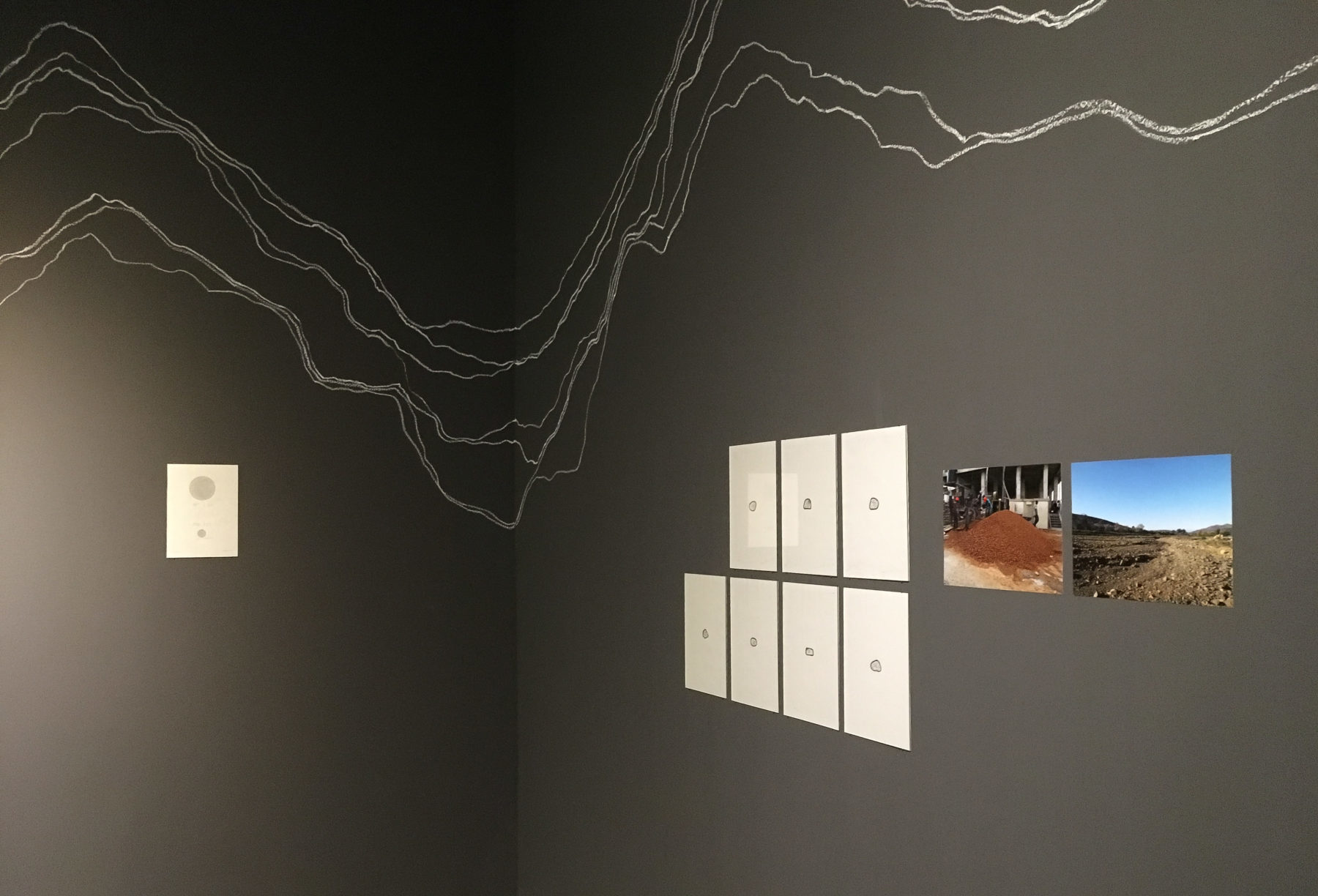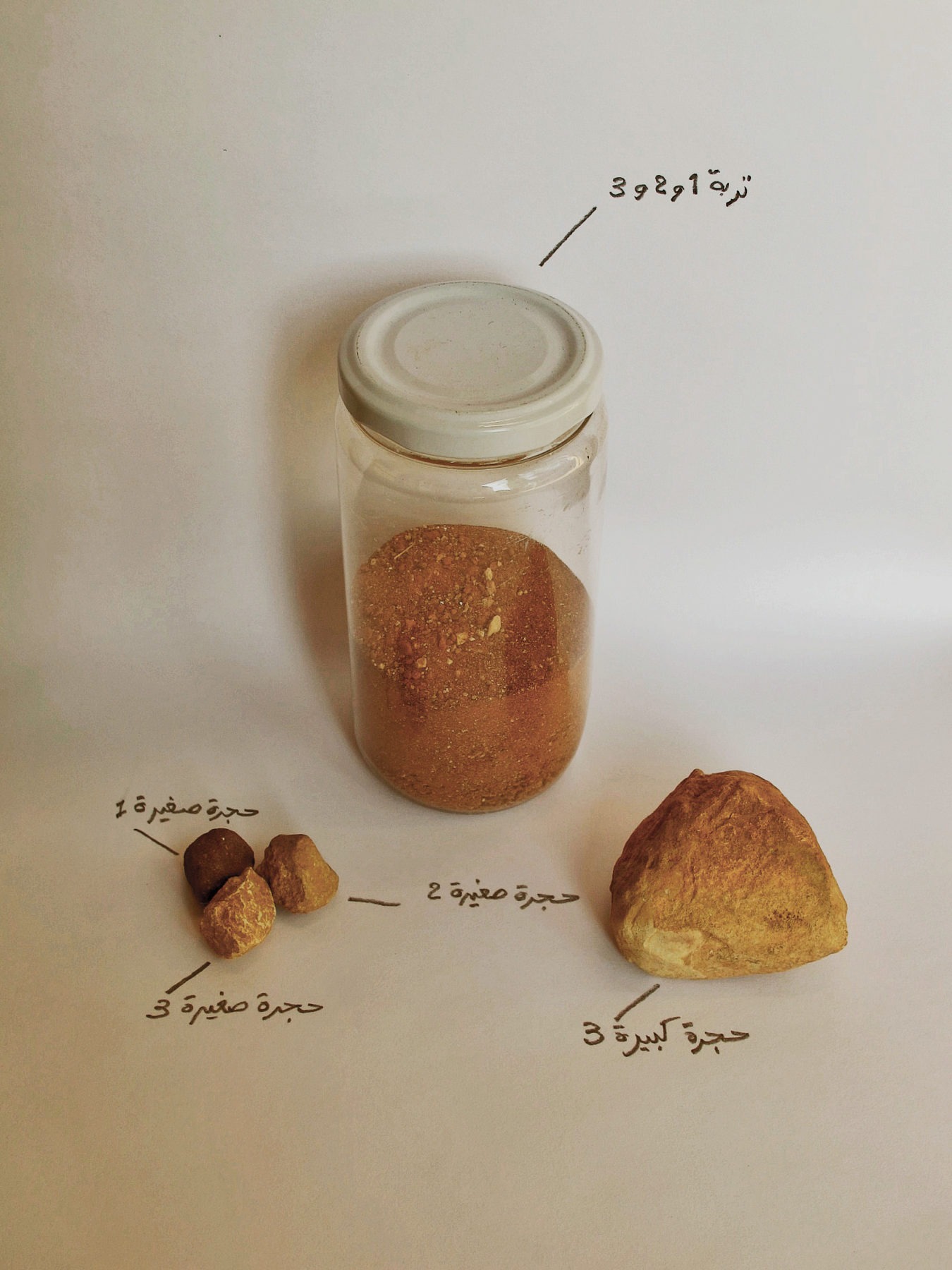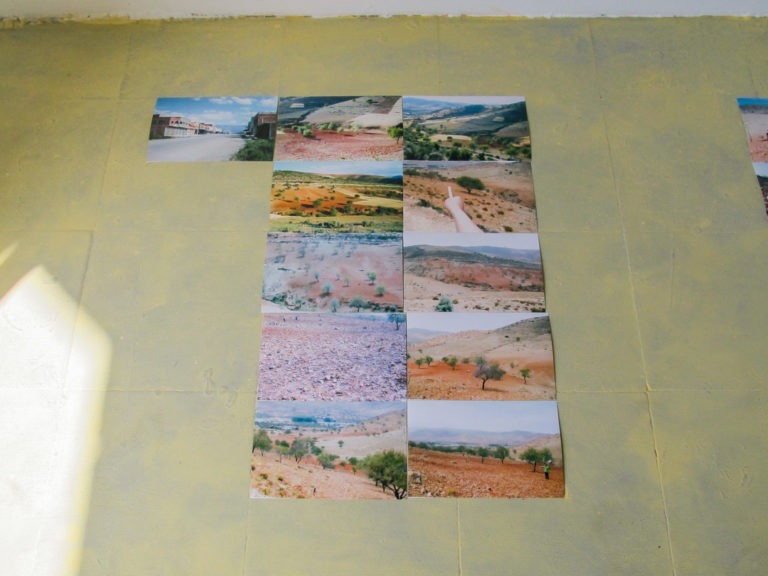Younès Rahmoun: Little Worlds, Complex Structures
From September 19 to October 20, 2018
Exhibit Opening
September 19, 2018 at 6pm
Curator(s)
Artist(s)
Location
The Gallery at VCUarts Qatar
Acknowledgment
Gallery Imane Fares, Faheem Bhat
Younès Rahmoun: Little Worlds, Complex Structures triangulates three works exploring positions of agency and being in the world.
In Jabal-Hajar-Turab #11 (2018) the artist looks outwards to the Rif mountains in Morocco where he is from, exploring the connection between the natural organic materials of the earth and their role in the construction of collective identity and belonging.
As a space for individual meditation Markaba (2016) is a geometric sculpture of six pyramids that draws on science and spirituality in its construction and meaning, riffing on the logic of the camera obscura, opening to the universe from its interior. In the video Khamsa (2011) the creative act is staked as an active position of engagement with the social and political urgencies of the world.
In these works, natural organisms, geometry, and creative expression are called on as new materials and forms to give shape to ways of seeing and imagining constellations of small worlds and complex structures in daily life and the universe. Looking through these prisms reveals the necessity and the agency we have to be present in context, and acknowledge the infinite potentiality all around us.

Interview
Younès Rahmoun in conversation with Laura Barlow
LAURA BARLOW (LB): Jabal-Hajar-Turâb #11 is the grounding work in the exhibition. It began a number of years ago and has been made in various iterations across different countries and exhibitions. What are the original references and meanings for you in the work?
YOUNES RAHMOUN (YR): Jabal-Hajar-Turâb began in 2009 at the Marakesh Biennale in Morocco. I showed it with elements of another work, Ghorfa, with three trees, some earth from the Rif, and a small maquette Ghorfa. One year later I showed it in Palermo, Italy, at the invitation of Abdellah Karroum.
Jabal-Hajar-Turâb stems from a desire to develop an existing project of exchanging stones into something larger, so the project takes its meaning, origins, and title, from the mountain, stone, and earth.
LB: Why were you drawn to working with these three materials at the beginning of the project – was it connected to a desire to investigate the place you are from?
YR: I wanted to talk about my origins but also the movement in my story. My grandfather came from the Rif Mountains to the city of Tetouan in Morocco as a soldier in the Spanish military. There he married my grandmother starting our family story in Tetouan. Immigration is still a part of my family’s story, and in the project I refer to this movement undertaken by humans, planets, and the earth’s elements in the universe. The work is about the matter that composes the universe that is also responsible for changing it.
LB: In your work there is a presence of architecture and a pragmatic and spiritual reading of spaces of habitation from an individual and collective perspective. One element of Jabal-Hajar-Turâb is about the construction of the houses in the Rif Mountains. How did that investigation begin?
YR: Jabal-Hajar-Turâb makes a connection between this part of the world, a precise point, and the universe. With the video Ghorfa 4 that is in Jabal-Hajar-Turâb I talk about the architecture and constriction in the Rif Mountains, looking at why people started to make houses with modern materials that came from the cities. When I made the Ghorfa structure – which the video documents the making of – I tried to use strong materials from this place in a way that was critical but intended to suggest some solutions to the issue of old and new.
LB: You’ve described Jabal-Hajar-Turâb as a work that shapes an external connection and Markaba igniting an introspective experience. How does Markaba operate as both an object and a tool to read small worlds within the larger structure of the universe?
YR: Markaba is a perfect mathematically designed geometric form; it’s almost industrial. Jabal-Hajar-Turâb is organic and natural; the small elements, the stones, travel around the world and exchange. It’s more intimate and the drawing on the wall is also something really organic. Markaba has a specific form but it’s also more philosophic, a more conceptual abstract object, like a stone, like a plant. But there is still a connection between them.
LB: Does Markaba have an experiential function?
YR: In the beginning, Markaba expanded from the black box, the camera obscura. The camera obscura receives light through a single, small hole. In Markaba there are six holes, or five points and a sixth hole positioned facing the ground that is the entrance. Inside, one sees five sources of light through the five holes. In the sixth hole the light comes from the front, behind, right, left, up, and down. It’s from the future, the past, the east, the west, the north, and the south.
Markaba represents the two elements of time and space with the six directions of light. This camera obscura can’t give us a picture, or an image inside the box, but when we are inside, in the center, it gives us an idea of being between the future and the past, between the north and the south, the east and the west. I am in the center, you are in the center – we are each in the center in the world, in this universe, in the past, the present, and the future. When one exists, we are in the center of our past, time, and place.
LB: You made Khamsa in five different locations, one of them being Doha. How is this work about individual agency in the world and the right to self-expression?
YR: For many years my work has referred to the problems and concerns of people around me in my country or other places around the world. I started making Khamsa in 2011 when I was in Doha for a workshop at Mathaf. I saw what was happening in Egypt and Tunisia as reported by Al Jazeera and wanted to make something related to this reportage.
In the film I perform many characters, starting with myself an artist and a teacher, but I also imagine myself as a lawyer, an architect, and a politician – for example, perspectives or positions that we can all summon. Each character is given five minutes to express ideas on how to change the world. I held the camera in my left hand and used my right hand to control what was in front of me, suggesting that there are multiple lenses through which to see and read what is happening around us, and that we can all be agents of change and expression, to shape the formation of unassuming found objects as well as the world more generally. I only saw my hand through the camera, just as we saw Al Jazeera’s reportage of the events in Cairo and other places where political unrest and revolutions were taking place.
I am in the center, you are in the center – we are each in the center in the world, in this universe, in the past, the present, and the future. When one exists, we are in the center of our past, time, and place.
- Artist Younès Rahmoun



Biographies

@withyounesrahmoun
younesrahmoun.com
Younès Rahmoun works across installation, drawing, performance and video to explore expanded networks of social environments and theological belief systems.
Recent solo exhibitions include Hijra, Galerie Imane Farès, Paris (2018) and From the Sea to the Ocean (De la Mer à l’Océan), L’appartement 22, Rabat (2016).
His work has been presented in numerous group exhibitions internationally including Viva Arte Viva, 57th Venice Biennial (2017); Volumes Fugitifs, Mohammed VI Museum, Rabat (2016); Sous nos Yeux (Before Our Eyes), MACBA, Barcelona (2014); Neighbours, Istanbul Modern, Istanbul (2014); Intense Proximity, La Triennale, Palais de Tokyo, Paris, France (2012); and Told Untold Retold, Mathaf: Arab Museum of Modern Art, Doha (2010).
His work is held in international collections including CAP Contemporary Art Platform, Kuwait; Centre Pompidou, Paris; MACBA, Barcelona; and Mathaf: Arab Museum of Modern Art, Doha. He is a graduate of the Institut National des Beaux-Arts, Tetouan. Rahmoun lives and works in Tetouan.

Laura Barlow is a Curator at Mathaf: Arab Museum of Modern Art, in Doha, Qatar.
Recent curated projects include Hana Al Saadi: Proposal for a Public Sculpture, 2018; Basim Magdy: It All Started With a Map and a Picture of Scattered Little Houses, 2017; Hassan Sharif: Objects and Files, 2016; and Saloua Raouda Choucair: The Meaning of One, The Meaning of the Multiple, 2015.
At e-flux, New York (2010-2014) she organized exhibitions with Mariana Silva and Pedro Neves Marques, Khalil Rabah, Rossella Biscotti, and Hito Steyerl.
She holds an MA in Curating from Bard College, New York, USA, and is a PhD candidate at the Bauhaus-Universität Weimar Institute of History and Theory of Architecture, Germany.
Public Programming
Sept. 20, 2018 ― 12:30 to 13:30 PM
Qatar Foundation Art Trail: Guided tour with Younès Rahmoun and Laura Barlow
Video
Little Worlds, Complex Structures at The Gallery at VCUarts Qatar
©Younès Rahmoun, 2018
Photo Gallery
For many years Rahmoun has experimented with a practice of exchanging stones from the Rif mountains in Morocco, where his family is originally from, with stones from other parts of the world. In the ongoing series Jabal-Hajar-Turâb (‘Mountain-Stone-Soil’), first initiated in 2009, Rahmoun looks to the Rif mountains to experiment with the making of new aesthetic forms that draw on this cultural heritage. Bringing together natural organic materials that are from, or related to this context, Rahmoun considers the varied interaction of these elements over time as they are changed by external forces or the cosmic structures of the universe, that in turn are effected by, or respond to the movement and migration of people as imposed by social and political change. The multi-layered installation includes a wall drawing of the Rif mountains silhouette, stones, dirt, and photographs that document the stones as they are moved from different environments, from the Rif to Cotonou in Benin, and from the Rif to the forests of Landes in France. Drawings of plants and vegetation made throughout this ongoing project reference growth and the progression of time. The video Ghorfa 4 – another ongoing series by the artist – looks at the making of the architecture that is hand built by the local community in the village Beni Boufrah in the Rif mountains (where the artist’s mother is from), considering the impact of modern materials on the retention of traditional construction practices. Collectively these elements share a fluid portrait of the natural forces of the cosmos while recognizing that society’s intuitive responses and processes of revision can be adopted for positive impact and change.
Related Topics
Crossing Boundaries Lecture
Exhibition
Crossing Boundaries Lecture